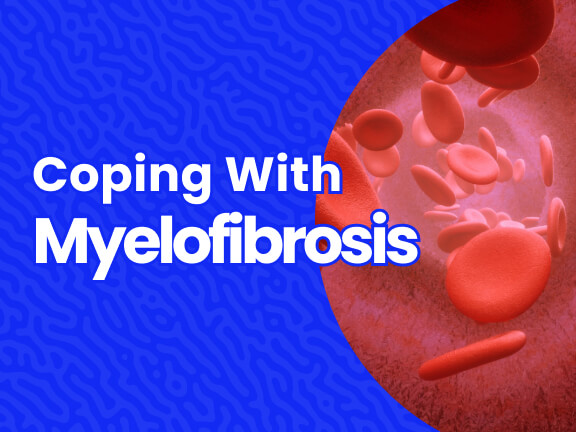Coping with Myelofibrosis
Myelofibrosis is a rare disease that can be fatal if not treated appropriately. Normally, the bone marrow is responsible for producing all kinds of blood cells. Myelofibrosis (MF) disrupts this condition and causes the bone marrow to produce scar tissue instead of vital cells. This situation brings with it many diseases. It can complicate the life of the patient or his relatives. For this reason, it is necessary to understand the condition very well and be prepared for what the disease will bring.
To get to know the disease more closely, we have compiled the questions you may have about how you can live and cope with myelofibrosis.
Can You Live a Normal Life With Myelofibrosis?

Although myelofibrosis is a rare, chronic, and complex disease, it is possible to continue your daily life depending on the stage of the disease. By establishing effective communication with your healthcare team, you can alleviate symptoms with appropriate treatment. You can manage your energy, such as by eating healthily and exercising moderately.
Why is Communication to The Health Team Important?
To fight the disease, you need to understand each stage of the condition very well. Get your doctor’s detailed information about all processes of the disease. Ask sincerely any questions that come to your mind. Be aware of the medications given by the doctor and their use, as you may need to use regular medication throughout the disease.
Is Emotional Support Necessary for Myelofibrosis?

Emotional stress is significant in the treatment of myelofibrosis, as in other chronic diseases. Sometimes you may need help doing elementary tasks. Ask your loved ones for support and let them help you. Inform your loved ones about the details of your illness, the processes of the disease, and what you will experience during this process. Experiencing the process together increases your strength. Also, you can connect to other people coping with similar situations. In addition, eating healthily, doing activities such as walking, swimming, or yoga increases your energy and motivation and helps you to reduce the stress that comes with the disease.
Is Myelofibrosis Painful?
Pain is one of the most common complaints of myelofibrosis. But there are different reasons and degrees for this. First of all, one of the most common myelofibrosis symptoms is swelling in the spleen. If the spleen gets too large, it can cause pain when it puts pressure on other parts of the body. Also, myelofibrosis causes inflammation of the connective tissues surrounding bones when the bone marrow hardens. This creates pain and tenderness in the bones and joints.
In addition, gout is one of the complications of myelofibrosis. When the body breaks down foods like steak, meat, and seafood, it makes uric acid. If a person has myelofibrosis, the patient’s body produces more uric acid than usual. Accumulating uric acid causes needle-like crystals in the joints, sharp pain, swollen joints, and inflammation.
Can Myelofibrosis Affect the Brain?
Myelofibrosis can occur anywhere in the body, and tumors can develop elsewhere in your body, such as the lymph nodes, spinal cord, and lungs. Since these tumors cannot be eliminated from the body, they affect the brain. When the red blood count is low, the heart works harder to supply oxygen to the brain and other organs. This can cause fatigue, chest pain, and dizziness. In addition, worsening anemia when myelofibrosis is not treated leads to fatigue and weakness. This condition can affect not only the brain but also the cardiovascular system and the lungs, causing heart failure, stroke, and worsening of pre-existing lung diseases.
Another question that comes to our mind here maybe: Does myelofibrosis cause memory loss? The answer is yes. Memory loss can be found among people with primary myelofibrosis, especially for people who are female, 60+ old.
What Happens if Myelofibrosis Goes Untreated?
Blood tests are significant for the diagnosis of myelofibrosis because it shows the same symptoms as anemia, leukocytosis/leukocytopenia, thrombocytosis/thrombocytopenia, splenomegaly, and hepatomegaly. Since the disease occurs in blood cells, its prognosis is poor if left untreated. Treatment aims to reduce symptoms and prevent disease progression. Therefore, if left untreated, the survival rate decreases, and the chance of death increases.
While successful results can be achieved with regular treatment, the following complications may occur if myelofibrosis is not treated:
- Fatigue is infuriating, and the patient’s quality of life is greatly reduced.
- Swelling in the spleen is a common symptom of myelofibrosis, and if spleen swelling persists, it can cause worsening of pain in the spleen, abdomen, and back and even cause a splenic infarction.
- Normally, blood flow from the spleen enters the liver through a large blood vessel called the portal vein. Increased blood flow from an enlarged spleen can lead to high blood pressure in the portal vein (portal hypertension). As the excess blood in the stomach and esophagus will force the smaller vessels, this can cause the vessels to rupture and bleed.
- Blood cells (extramedullary hematopoiesis) may occur outside of the bone marrow. This can cause tumor formation in other parts of the body. These tumors can cause problems in the gastrointestinal tract such as bleeding, coughing or spitting blood, spinal cord compression, or seizures.
- Some people with myelofibrosis may develop acute myeloid leukemia and bone marrow failure, which is a rapidly progressing cancer of the blood and bone marrow.
What Is the Best Treatment for Myelofibrosis?
Myelofibrosis is a disease that can differ from person to person and can be seen in different regions. Therefore, treatment options are also different. Although some patients are diagnosed with myelofibrosis, the patient may not need treatment right away. The doctor monitors the patient for a while and prepares treatment options according to criteria such as the rate of spread of the disease, its stage, symptoms, and the organs it affects. In the treatment of myelofibrosis whose type is determined, methods such as antibiotic therapy, biotherapy, radiotherapy, chemotherapy, stem cell transplantation can be applied, and successful results are measured with these methods.
Are There Any New Treatments for Myelofibrosis?
Stem cell transplantation is the only known curative treatment for primary myelofibrosis, but this treatment is only recommended for high- and intermediate-risk patients.
Research continues on JAK2, immunomodulatory and epigenetic drugs in the treatment of PMF. Ruxolitinib, a JAK2 inhibitor, was the first targeted therapy identified for PMF.
Momelotinib is another JAK2 inhibitor being studied for the treatment of PMF. Initial studies noted a reduction in spleen size in 45 percent of people taking momelotinib. About half of the people studied showed improvement in their anemia, and more than 50 percent were able to stop transfusion therapy.
In August 2019, the FDA approved federatinib for the treatment of adults with intermediate-2 or high-risk MF.
In February 2022, the FDA granted accelerated approval for Vonjo (pacritinib) to treat adults with intermediate or high-risk primary or secondary myelofibrosis and platelet (blood clotting cells) levels below 50,000/µL.
According to new research from the UVA Cancer Center, the drug Palbociclib, used to treat certain advanced breast cancers, may prevent bone marrow scarring that current treatments for myelofibrosis can’t. The drug used in the study was observed to reduce bone marrow scarring, reduce the abnormally high white blood cells seen in myelofibrosis, and shrink the enlarged spleens of the mice in two different mouse models.
To learn more about Myelofibrosis, read our ultimate guide: Myelofibrosis Ultimate Guide
Sources:













2 Comments
I’m a 62 years old woman diagnosed with stage 3 myleofibrosis and I am taking Hydrea and Eliquis for blood clots. My platelets continue to rise, and my spleen is getting bigger. Can clinical trials help me?
I am sorry to hear that you are having a tough time. We can help with connecting you to the clinical trials that best match your diagnosis.